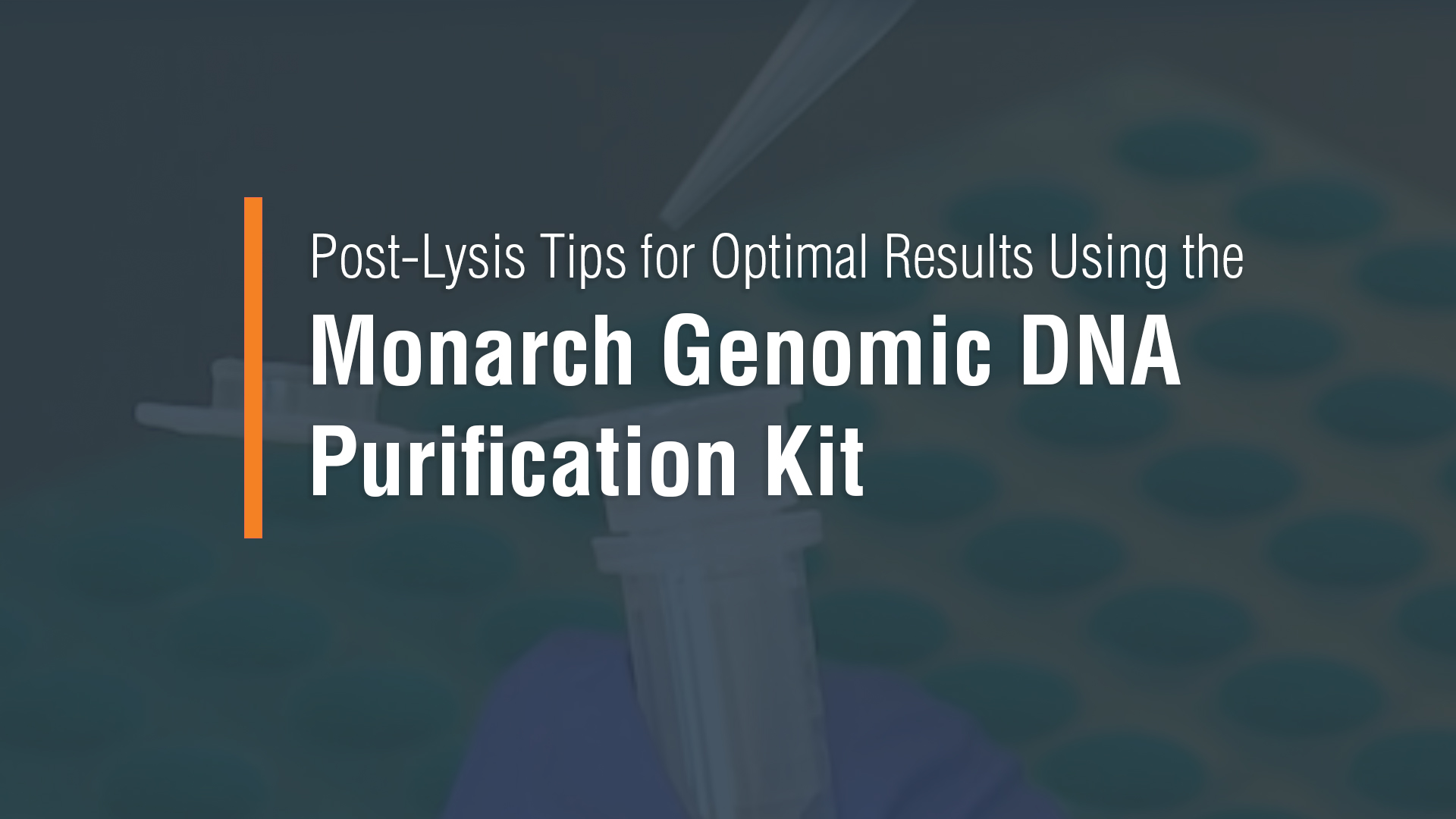Genomic DNA Extraction from Insects
Before you Begin:
- Store RNase A and Proteinase K at -20°C.
- Add ethanol (≥ 95%) to the Monarch gDNA Wash Buffer concentrate as indicated on the bottle label.
- Add 1/10th volume of 0.5 M EDTA (pH 8.0) to the necessary amount of Tissue Lysis Buffer; each sample will require 200 μl of this modified tissue lysis buffer (e.g., for a single sample, add 20 μl of 0.5 M EDTA to 180 μl of Tissue Lysis Buffer).
- Set a thermal mixer (e.g. ThermoMixer or similar device), or a heating block to 56°C for sample lysis.
- Set a heating block to 60°C. Preheat the appropriate volume of elution buffer to 60°C (35–100 µl per sample). Confirm the temperature, as temperatures are often lower than indicated on the device.
- Do not load a single column with the lysed sample more than once; over-exposure of the matrix to the lysed sample can cause the membrane to expand and dislodge
Protocol:
Part 1: SAMPLE LYSIS
- Grind 10-20 mg of insect material with a microtube pestle.
- Add 10 ul Proteinase K and 200 µl of the modified Tissue Lysis Buffer (containing EDTA) to each sample. Mix immediately by vortexing. Ensure tissue particles are able to move freely in the lysis mix and do not stick to the bottom of the tube. When working with multiple samples, prepare a master mix of Tissue Lysis Buffer and Proteinase K to save pipetting steps.
- Incubate at 56°C in a thermal mixer with agitation at full speed (1400 rpm) until tissue pieces have completely dissolved (typically 30-60 minutes). If time is not limiting, additional incubation up to 3 hours can further improve yields and decrease residual RNA. If an incubator with agitation is not available, use a tube rotator placed within an incubator, shaking water bath or a heating block (vortex samples every 5-15 minutes to speed up lysis).
- Centrifuge for 3 minutes at maximum speed (> 12,000 x g) to pellet debris. Transfer the supernatant to a fresh microfuge tube. This prevents residual debris from clogging the membrane binding sites and helps to reach maximal yield and purity. It is especially important to perform this step if sample appears turbid, contains residual particles, when working with stabilized tissue, or when working with brain or fibrous tissues.
- Add 3 µl of RNase A to the lysate, vortex thoroughly and incubate for a minimum of 5 minutes at 56°C with agitation at full speed. This step can be skipped if a low percentage of co-purified RNA will not affect downstream applications.
- Proceed to Part 2: Genomic DNA Binding and Elution
Part 2: GENOMIC DNA BINDING AND ELUTION
- Add 400 μl gDNA Binding Buffer to the sample and mix thoroughly by pulse-vortexing for 5-10 seconds. Thorough mixing is essential for optimal results.
- Transfer the lysate/binding buffer mix (~600 μl) to a gDNA Purification Column pre-inserted into a collection tube, without touching the upper column area. Proceed immediately to step 3. Do not reload the same column with more sample; over-exposure of the matrix to the lysed sample can cause the membrane to expand and dislodge. Avoid touching the upper column area with lysate/binding mix and avoid transferring foam that may have formed during lysis. Any material that touches the upper area of the column, including any foam, may lead to salt contamination in the eluate.
- Close the cap and centrifuge: first for 3 minutes at 1,000 x g to bind gDNA (no need to empty the collection tubes or remove from centrifuge) and then for 1 minute at maximum speed (> 12,000 x g) to clear the membrane. Discard the flow-through and the collection tube. For optimal results, ensure that the spin column is placed in the centrifuge in the same orientation at each spin step (for example, always with the hinge pointing to the outside of the centrifuge); ensuring the liquid follows the same path through the membrane for binding and elution can slightly improve yield and consistency.
- Transfer column to a new collection tube and add 500 μl gDNA Wash Buffer. Close the cap and invert a few times, so that the wash buffer reaches the cap. Centrifuge immediately for 1 minute at maximum speed (12,000 x g), and discard the flow through. The collection tube can be tapped on a paper towel to remove any residual buffer before reusing it in the next step. Inverting the spin column containing wash buffer prevents salt contamination in the eluate.
- Reinsert the column into the collection tube. Add 500 μl gDNA Wash Buffer and close the cap. Centrifuge immediately for 1 minute at maximum speed (>12,000 x g), then discard the collection tube and flow through.
- Place the gDNA Purification Column in a DNase-free 1.5 ml microfuge tube (not included). Add 35-100 μl preheated (60°C) gDNA Elution Buffer, close the cap and incubate at room temperature for 1 minute. Elution in 100 μl is recommended, but smaller volumes can be used and will result in more concentrated DNA but a reduced yield (20–25% reduction when using 35 μl). Eluting with preheated elution buffer will increase yields by ~20–40% and eliminates the need for a second elution. For applications in which a high DNA concentration is required, using a small elution volume and then eluting again with the eluate may increase yield (~10%). The elution buffer (10 mM Tris-Cl, pH 9.0, 0.1 mM EDTA) offers strong protection against enzymatic degradation and is optimal for long term storage of DNA. However, other low-salt buffers or nuclease-free water can be used if preferred. For more details on optimizing elution, please refer to “Considerations for Elution & Storage” in the product manual.
- Centrifuge for 1 minute at maximum speed (> 12,000 x g) to elute the gDNA.

